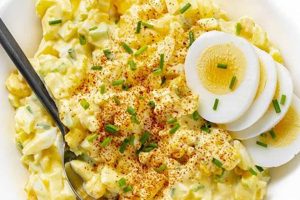A basic preparation combining cooked eggs, mayonnaise, and seasonings constitutes a quick and easy meal or snack. Variations often include additions like mustard, celery, onion, or relish, offering diverse flavor profiles. This dish provides a convenient way to utilize readily available ingredients and can be served in sandwiches, on crackers, or as a salad topping.
The enduring popularity of this classic dish stems from its affordability, ease of preparation, and nutritional value. Eggs provide a good source of protein and essential nutrients. Historically, similar preparations have existed for centuries, evolving alongside refrigeration and the widespread availability of mayonnaise, solidifying its place as a common household staple. Its adaptability to various tastes and dietary preferences through ingredient substitutions further enhances its appeal.
This discussion will explore various aspects of crafting this versatile dish, including optimal egg cooking techniques, mayonnaise selection, recommended seasonings, and creative additions for personalized flavors. It will also address food safety considerations and offer suggestions for presentation and serving.
Tips for Creating a Delicious Egg Salad
Achieving a flavorful and well-textured egg salad involves attention to detail in each step of the preparation process. The following tips offer guidance for optimal results.
Tip 1: Perfect Egg Cooking: Overcooked eggs can result in a dry, rubbery texture. Aim for a firm yet moist yolk by placing eggs in a single layer in a saucepan, covering them with cold water, and bringing the water to a rolling boil. Once boiling, remove the pan from the heat, cover, and let the eggs sit for 10-12 minutes, depending on size. Immediately transfer the eggs to an ice bath to stop the cooking process.
Tip 2: Chopping Consistency: Uniformly chopped eggs contribute to a pleasing texture. A good method involves using an egg slicer for even pieces or finely chopping by hand for a smoother consistency. Avoid overly mashing the eggs, which can create a paste-like texture.
Tip 3: Mayonnaise Selection: The choice of mayonnaise significantly impacts the final flavor. While classic mayonnaise is a standard choice, experimenting with flavored varieties, such as olive oil or Dijon mustard mayonnaise, can add depth and complexity.
Tip 4: Seasoning Balance: Proper seasoning enhances the overall flavor profile. A blend of salt, black pepper, and a touch of paprika provides a balanced base. Consider incorporating other complementary spices like dill, chives, or celery seed.
Tip 5: Ingredient Incorporation: Gentle folding prevents overmixing and maintains the desired texture. Add the mayonnaise and other ingredients gradually, mixing until just combined. Avoid vigorous stirring, which can break down the eggs.
Tip 6: Chill Time: Allowing the egg salad to chill in the refrigerator for at least 30 minutes enhances the flavors and allows them to meld. This step also improves the overall texture and makes the salad easier to spread or serve.
Tip 7: Freshness and Storage: For optimal quality and food safety, consume the egg salad within 3-5 days of preparation. Store it in an airtight container in the refrigerator.
By following these tips, one can consistently produce an egg salad characterized by balanced flavors, pleasant textures, and visual appeal.
This discussion concludes with recipe variations and serving suggestions to further elevate this simple yet satisfying dish.
1. Hard-boiled Eggs
Hard-boiled eggs form the cornerstone of a simple egg salad recipe. Their preparation and quality significantly influence the final dish’s texture, flavor, and overall appeal. Understanding the nuances of cooking and handling hard-boiled eggs is crucial for a successful egg salad.
- Cooking Method:
Proper cooking yields a firm, yet moist yolk, avoiding the unpleasant sulfurous odor and dry texture associated with overcooking. Methods range from traditional stovetop boiling to steaming or baking. Each technique impacts the egg’s final texture and ease of peeling. A consistent cooking method ensures predictable results in egg salad preparation.
- Freshness and Quality:
Fresh, high-quality eggs contribute to both flavor and safety. Older eggs can be more challenging to peel and may possess a less desirable flavor. Selecting fresh eggs ensures optimal binding with the mayonnaise and other ingredients, creating a cohesive and flavorful egg salad.
- Peeling Technique:
Cleanly peeled eggs enhance the aesthetic appeal of the salad. Various techniques exist, including gently tapping the shell all over, rolling the egg on a flat surface, or using a spoon to separate the shell from the egg white. A smooth, unblemished egg white contributes to a more visually appealing final dish.
- Chopping and Handling:
The size and consistency of the chopped eggs affect the texture of the egg salad. Uniformly chopped eggs create a pleasant mouthfeel, while over-mashing can lead to a pasty consistency. Careful handling prevents the yolks from crumbling excessively, preserving the desired texture and visual appeal of the salad.
Mastery of these elements ensures the hard-boiled eggs provide the ideal foundation for a simple, yet delicious egg salad. The quality of the hard-boiled eggs directly impacts the final product’s taste, texture, and visual appeal, emphasizing their crucial role in this classic dish. From the initial cooking process to the final chop, attention to detail elevates the humble hard-boiled egg to a key component of a successful egg salad.
2. Mayonnaise
Mayonnaise plays a crucial role in egg salad, acting as the binding agent that brings the other ingredients together. Its creamy texture and tangy flavor contribute significantly to the overall sensory experience. The quality and type of mayonnaise selected directly impact the final product’s taste, texture, and overall appeal.
- Emulsification and Texture:
Mayonnaise is an emulsion of oil and egg yolks, stabilized by an emulsifier, typically lecithin found naturally in egg yolks. This emulsion creates a smooth, creamy texture that coats the other ingredients, binding them together and providing a luxurious mouthfeel. The stability of this emulsion is crucial for preventing the egg salad from becoming watery or separating.
- Flavor Profile:
The flavor profile of mayonnaise, primarily derived from oil, egg yolks, vinegar or lemon juice, and seasonings, complements the mild flavor of hard-boiled eggs. Different types of mayonnaise, such as those made with olive oil or flavored with mustard, can introduce nuanced flavors that enhance the overall complexity of the egg salad.
- Quantity and Ratio:
The amount of mayonnaise used influences the egg salad’s consistency and richness. Too little mayonnaise can result in a dry, crumbly texture, while too much can make it overly rich and heavy. Achieving the correct balance ensures a pleasant texture and optimal flavor distribution.
- Quality and Freshness:
Using high-quality, fresh mayonnaise contributes to both flavor and food safety. The quality of the oil and eggs used in the mayonnaise production impacts its overall flavor profile. Freshness ensures optimal flavor and minimizes the risk of spoilage.
The careful selection and proper incorporation of mayonnaise are essential for creating a well-balanced and flavorful egg salad. Mayonnaise not only binds the ingredients together but also contributes significantly to the overall taste and texture of the dish. Understanding its role and selecting the appropriate type and quantity are crucial for a successful outcome.
3. Seasoning
Seasoning is essential for elevating a simple egg salad recipe from bland to flavorful. The judicious use of spices and seasonings complements the mild taste of eggs and mayonnaise, creating a balanced and satisfying culinary experience. Understanding the role of various seasonings allows for customization and depth of flavor.
- Salt and Pepper:
Salt and freshly ground black pepper provide the foundational seasoning for egg salad. Salt enhances the inherent flavors of the other ingredients, while pepper adds a subtle bite. The balance between these two seasonings is crucial; too much salt can overpower the dish, while too little pepper can leave it lacking dimension.
- Herbs:
Fresh herbs, such as dill, chives, parsley, or tarragon, introduce bright, aromatic notes to egg salad. These herbs can be finely chopped and added directly to the mixture. Their delicate flavors complement the richness of the mayonnaise and eggs, creating a refreshing counterpoint. The choice of herbs can significantly influence the overall flavor profile, offering opportunities for customization.
- Spices:
Spices like paprika, mustard powder, or celery seed offer warm, earthy undertones. Paprika adds a touch of smokiness and vibrant color, while mustard powder contributes a subtle tang. Celery seed provides a distinct savory note reminiscent of celery itself. These spices add complexity and depth, enhancing the overall flavor profile.
- Acids:
A touch of acidity, often in the form of lemon juice or vinegar, brightens the flavors of egg salad. The acidity cuts through the richness of the mayonnaise, providing a refreshing balance. It also helps to preserve the salad and enhance its overall flavor profile. A small amount can significantly impact the final taste.
The careful selection and combination of seasonings are key to crafting a truly delicious egg salad. The interplay of salt, pepper, herbs, spices, and acids creates a symphony of flavors that elevate this simple dish to a culinary delight. Experimentation with different seasoning combinations allows for personalization and the creation of unique flavor profiles tailored to individual preferences.
4. Mix Gently
The “mix gently” instruction within a simple egg salad recipe carries significant weight in achieving the desired final product. This seemingly minor detail plays a crucial role in the overall texture and consistency of the egg salad. Aggressive mixing can lead to over-broken egg pieces, resulting in a mushy, less appealing texture. The goal is to combine the ingredients thoroughly while preserving the integrity of the egg pieces. This gentle approach ensures a pleasant mouthfeel with distinct textural elements. For example, if one were to use a vigorous whisking motion, the yolks would disintegrate, creating a denser, paste-like consistency rather than the desired light and slightly chunky texture.
The practical significance of this gentle mixing technique becomes particularly apparent when considering the other components of the egg salad. Mayonnaise, a key ingredient, possesses a delicate emulsion that can be disrupted by excessive force. Overmixing can cause the mayonnaise to break down, leading to a thinner, less creamy consistency. Furthermore, delicate ingredients like chopped fresh herbs or finely diced vegetables, often added for flavor and texture, benefit from a gentle approach. Rough handling can bruise these delicate additions, diminishing their visual appeal and potentially affecting their flavor contribution. This careful mixing ensures that the flavors and textures of all the ingredients are harmoniously integrated.
Maintaining a light hand during the mixing process preserves the distinct identity of each ingredient within the egg salad while creating a unified and flavorful dish. The result is a visually appealing egg salad with a pleasant texture, showcasing the individual components while allowing them to meld harmoniously. Failing to appreciate the importance of this gentle approach can compromise the overall quality of the egg salad, highlighting the crucial role this simple instruction plays in achieving a successful outcome.
5. Chill
The chilling process plays a crucial role in enhancing the flavor and texture of a simple egg salad recipe. This step, often overlooked, allows the flavors of the various ingredients to meld and deepen, resulting in a more cohesive and satisfying final product. Furthermore, chilling firms the texture of the egg salad, making it easier to handle and serve.
- Flavor Development:
Chilling allows the individual flavors of the ingredientseggs, mayonnaise, seasonings, and any additionsto harmonize. This melding of flavors creates a more complex and nuanced taste profile compared to a freshly made, unchilled egg salad. The lower temperature slows down chemical reactions, allowing the flavors to deepen and integrate over time.
- Texture Enhancement:
The chilling process firms the consistency of the egg salad. This is particularly important for achieving a desirable texture when spreading the salad on bread or crackers. A chilled egg salad holds its shape better, preventing it from becoming too runny or watery.
- Food Safety:
Chilling is essential for food safety, especially with perishable ingredients like eggs and mayonnaise. Lowering the temperature inhibits the growth of bacteria that can cause foodborne illness. Prompt refrigeration after preparation is crucial for maintaining the safety and quality of the egg salad.
- Enhanced Serving Experience:
A chilled egg salad offers a more refreshing and palatable experience, particularly in warmer weather. The cool temperature contrasts pleasantly with the creamy texture and savory flavors, enhancing the overall enjoyment of the dish.
Incorporating a chilling period into a simple egg salad recipe significantly contributes to its overall quality, both in terms of flavor and texture. This seemingly simple step elevates the dish from a basic combination of ingredients to a more refined and enjoyable culinary experience. Chilling is therefore not merely a suggestion but a crucial element in achieving the optimal outcome for a simple egg salad recipe. It ensures food safety and provides a more satisfying sensory experience.
6. Serve
The “serve” aspect of a simple egg salad recipe encompasses more than simply placing the finished product on a plate. It involves considerations of presentation, accompanying elements, and the overall dining experience. Appropriate serving methods enhance the enjoyment of this classic dish, transforming it from a basic meal to a more satisfying culinary experience.
- Bread and Sandwiches:
Serving egg salad between slices of bread is a classic and convenient approach. The bread provides a neutral backdrop that complements the rich, creamy filling. Variations include using different types of bread, such as white, wheat, rye, or sourdough, each contributing a unique textural and flavor element. Toasting the bread adds a crisp counterpoint to the soft egg salad. Sandwiches offer portability and versatility, making them a popular choice for lunches, picnics, or quick meals. Adding lettuce, tomato, or other vegetables elevates the sandwich further, providing textural contrast and added nutrients.
- Crackers and Crostini:
Crackers or crostini offer a lighter, more delicate alternative to bread. Their crisp texture contrasts pleasantly with the creamy egg salad. Different cracker varieties, such as butter crackers, saltines, or multigrain crackers, offer diverse flavor profiles that complement the egg salad. Crostini, toasted slices of baguette, provide a more substantial base with a slightly crunchy texture. These options are well-suited for appetizers, snacks, or light lunches, allowing for portion control and easy handling.
- Salads and Bowls:
Egg salad can be a component of a larger salad or grain bowl, adding protein and richness. A bed of lettuce, spinach, or mixed greens provides a refreshing base, while other vegetables, such as tomatoes, cucumbers, or bell peppers, contribute color, texture, and nutrients. Grains like quinoa or brown rice add a hearty element. This approach offers a more balanced and complete meal, incorporating a variety of textures and flavors.
- Garnishes and Presentation:
Garnishing enhances the visual appeal and adds a final touch of flavor. Fresh herbs, such as chives, dill, or parsley, provide a pop of color and a subtle aromatic note. A sprinkle of paprika or a dash of hot sauce can add a touch of spice. Thoughtful presentation, whether arranging the egg salad on a platter with crackers or carefully assembling a sandwich, elevates the dining experience and demonstrates attention to detail. These final touches contribute to a more appealing and satisfying meal.
The manner in which egg salad is served significantly influences the overall dining experience. Considering the various serving options, from simple sandwiches to more elaborate salads, allows for customization and creativity. The choice of accompaniments, garnishes, and presentation enhances both the visual appeal and the enjoyment of this versatile and classic dish. A thoughtful approach to serving transforms a simple egg salad recipe into a more complete and satisfying meal.
Frequently Asked Questions
This section addresses common inquiries regarding the preparation and enjoyment of egg salad.
Question 1: How long can egg salad be safely stored in the refrigerator?
Properly stored egg salad, kept in an airtight container, typically remains safe for consumption for 3-5 days in a refrigerator maintained at 40F (4C) or below. Beyond this timeframe, the risk of bacterial growth increases significantly.
Question 2: What are signs that egg salad has spoiled?
Spoiled egg salad often exhibits a sour or off-putting odor. Changes in texture, such as excessive wateriness or sliminess, can also indicate spoilage. Discoloration, particularly a greenish tinge to the yolks, should be considered a warning sign. If any of these signs are present, discarding the egg salad is recommended.
Question 3: Can egg salad be frozen?
Freezing egg salad is generally not recommended. The mayonnaise base tends to separate and become watery upon thawing, resulting in an undesirable texture. The eggs themselves can also become rubbery after freezing. While freezing might not render the egg salad unsafe, it significantly compromises its quality.
Question 4: How can one achieve a smoother, less chunky texture?
A smoother egg salad texture can be achieved through finer chopping or mashing of the hard-boiled eggs. A ricer or food processor can aid in achieving a uniform consistency. Alternatively, using more mayonnaise can create a creamier, less textured final product. The degree of smoothness depends on individual preference.
Question 5: What are some healthy variations of traditional egg salad?
Healthier variations can incorporate Greek yogurt or avocado in place of some or all of the mayonnaise. These substitutions reduce overall fat content while maintaining a creamy texture. Incorporating additional vegetables, such as chopped celery, bell peppers, or red onion, boosts nutritional value and adds flavor complexity.
Question 6: How can one prevent the yolks from turning green when boiling eggs?
A greenish ring around the yolk is a result of overcooking. To prevent this, avoid boiling the eggs for excessively long periods. A cooking time of 10-12 minutes for large eggs is generally sufficient. Immediately transferring the cooked eggs to an ice bath stops the cooking process and helps prevent discoloration.
Understanding these common points of inquiry aids in ensuring the safe and enjoyable preparation and consumption of this classic dish.
The following section offers a selection of recipe variations to inspire culinary creativity and personalize the egg salad experience.
Egg Salad Simple Recipe
This exploration of the egg salad simple recipe has delved into the crucial elements that contribute to its enduring appeal: perfectly cooked eggs, balanced mayonnaise incorporation, thoughtful seasoning, gentle mixing techniques, adequate chilling time, and versatile serving options. Each component plays a vital role in achieving a final product characterized by harmonious flavors, pleasing textures, and visual appeal. From the initial selection of fresh, high-quality ingredients to the final presentation, attention to detail elevates this seemingly simple dish to a culinary staple.
The egg salad simple recipe, while straightforward in its essence, offers a canvas for culinary creativity. Adaptability to diverse palates through ingredient variations and serving styles ensures its continued relevance in kitchens worldwide. Further experimentation with flavor profiles and presentation promises continued enjoyment and exploration of this timeless classic.






